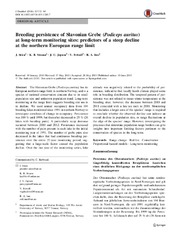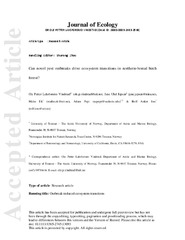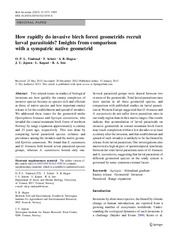Blar i forfatter "Jepsen, Jane Uhd"
-
Arctic greening and bird nest predation risk across tundra ecotones
Ims, Rolf Anker; Henden, John-André; Strømeng, Marita Anti; Thingnes, Anders Voss; Garmo, Mari; Jepsen, Jane Uhd (Journal article; Tidsskriftartikkel; Peer reviewed, 2019-07-01)Alarming global-scale declines of bird numbers are occurring under the changing climate, and species belonging to alpine and Arctic tundra are particularly affected. Increased nest predation appears to be involved4, but the mechanisms linking predation to climate change remain to be shown. Here we test the prediction from food web theory that increased primary productivity (greening of tundra) in a ... -
Breeding persistence of Slavonian Grebe (Podiceps auritus) at long-term monitoring sites: predictors of a steep decline at the northern European range limit
Stien, Jenny; Strann, Karl Birger; Jepsen, Jane Uhd; Frivoll, Vigdis Irene; Ims, Rolf Anker (Journal article; Tidsskriftartikkel; Peer reviewed, 2015-06-10)The Slavonian Grebe (Podiceps auritus) has its European northern range limit in northern Norway, and is a species of national conservation concern due to its small population size and unknown population trend. Long-term monitoring at the range limit suggests breeding site use is in decline. We used annual occupancy data from 104 breeding lakes monitored since 1991 in northern Norway to investigate ... -
Can novel pest outbreaks drive ecosystem transitions in northern-boreal birch forest?
Vindstad, Ole Petter Laksforsmo; Jepsen, Jane Uhd; Ek, Malin; Pepi, Adam A.; Ims, Rolf Anker (Journal article; Tidsskriftartikkel; Peer reviewed, 2018-11-04)<p>1.The boreal biome exhibits distinct alternative ecosystem states with high and low levels of tree cover. Insect outbreaks facilitated by climate warming could potentially drive transitions from high to low tree cover states. We investigated whether two key premises for such outbreak‐induced transitions – critical thresholds (tipping points) and positive feedbacks that could maintain alternative ... -
Does long-term grazing cause cascading impacts on the soil microbiome in mountain birch forests?
Ahonen, Saija H.K.; Ruotsalainen, Anna Liisa; Wäli, Piippa R.; Suominen, Otso; Vindstad, Ole Petter Laksforsmo; Jepsen, Jane Uhd; Markkola, Annamari (Journal article; Tidsskriftartikkel; Peer reviewed, 2024-02-01)In subarctic mountain birch forests, reindeer grazing and moth outbreaks act as important biotic drivers of ecosystem functioning. We investigated how a long-term contrast in reindeer grazing regimes and short-term ungulate exclusion affected soil fungal and bacterial communities in mountain birch forests recovering from a recent moth outbreak. We separately described the impacts on microbial ... -
Ecological stoichiometry and nutrient partitioning in two insect herbivores responsible for large-scale forest disturbance in the Fennoscandian subarctic
Metcalfe, Daniel B.; Cherif, Mehdi; Jepsen, Jane Uhd; Vindstad, Ole Petter Laksforsmo; Kristensen, Jeppe Å.; Belsing, Ulrika (Journal article; Tidsskriftartikkel; Peer reviewed, 2018-10-04)<p>1. Outbreaks of herbivorous insects can have large impacts on regional soil carbon (C) storage and nutrient cycling. In northernmost Europe, population outbreaks of several geometrid moth species regularly cause large‐scale defoliation in subarctic birch forests. An improved understanding is required of how leaf C and nutrients are processed after ingestion by herbivores and what this means for ... -
Elevationally biased avian predation as a contributor to the spatial distribution of geometrid moth outbreaks in sub-arctic mountain birch forest
Pepi, Adam A.; Vindstad, Ole Petter Laksforsmo; Ek, Malin; Jepsen, Jane Uhd (Journal article; Tidsskriftartikkel; Peer reviewed, 2017-04-03)1. Population dynamics and interactions that vary over a species’ range are of particular importance in the context of latitudinal clines in biological diversity.Winter moth (Operophtera brumata) and autumnal moth (Epirrita autumnata) are two species of eruptive geometrids that vary widely in outbreak tendency over their range, which generally increases from south to north and with elevation. 2. ... -
End-user involvement to improve predictions and management of populations with complex dynamics and multiple drivers
Henden, John-André; Ims, Rolf Anker; Yoccoz, Nigel; Asbjørnsen, Einar Johannes; Stien, Audun; Mellard, Jarad Pope; Tveraa, Torkild; Marolla, Filippo; Jepsen, Jane Uhd (Journal article; Tidsskriftartikkel; Peer reviewed, 2020-03-11)Sustainable management of wildlife populations can be aided by building models that both identify current drivers of natural dynamics and provide near-term predictions of future states. We employed a Strategic Foresight Protocol (SFP) involving stakeholders to decide the purpose and structure of a dynamic state-space model for the population dynamics of the Willow Ptarmigan, a popular game species ... -
Evidence of effects of herbivory on Arctic vegetation: a systematic map protocol
Soininen, Eeva M; Barrio, I.; Jepsen, Jane Uhd; Ehrich, Dorothee; Ravolainen, Virve T.; Speed, James David Mervyn (Journal article; Tidsskriftartikkel; Peer reviewed, 2018-09-27)<p><i>Background</i>: Along with climate change, herbivory is considered a main driver of ecosystem change in terrestrial Arctic environments. Understanding how herbivory influences the resilience of Arctic ecosystems to ongoing environmental changes is essential to inform policy and guide sustainable management practices. However, many studies indicate that the effects of herbivores on plants and ... -
High goose abundance reduces nest predation risk in a simple rodent-free high-Arctic ecosystem
Pedersen, Åshild Ønvik; Stien, Jennifer; Eidesen, Pernille Bronken; Ims, Rolf Anker; Jepsen, Jane Uhd; Stien, Audun; Tombre, Ingunn; Fuglei, Eva (Journal article; Tidsskriftartikkel; Peer reviewed, 2017-12-13)Breeding geese are the preferred prey of the Arctic fox Vulpes lagopus in the high-Arctic Svalbard archipelago. According to the <i>apparent competition hypothesis (ACH)</i>, less-abundant prey species (e.g. ptarmigan, waders and small passerines) will experience higher predation rates when breeding in association with the more common prey (geese), due to spill-over predation by the shared predator. ... -
How rapidly do invasive birch forest geometrids recruit larval parasitoids? Insights from comparison with a sympatric native geometrid
Laksforsmo Vindstad, Ole Petter; Schott, Tino; Hagen, Snorre; Jepsen, Jane Uhd; Kapari, Lauri Teemu; Ims, Rolf Anker (Journal article; Tidsskriftartikkel; Peer reviewed, 2013)Two related issues in studies of biological invasions are how quickly the enemy complexes of invasive species become as species-rich and efficient as those of native species and how important enemy release is for the establishment and spread of invaders. We addressed these issues for the geometrid moths Operophtera brumata and Agriopis aurantiaria, who invaded the coastal mountain birch forest ... -
Identification and Evaluation of 21 Novel Microsatellite Markers from the Autumnal Moth (Epirrita autumnata) (Lepidoptera: Geometridae)
Aarnes, Siv Grethe; Fløystad, Ida; Schregel, Julia; Vindstad, Ole Petter L.; Jepsen, Jane Uhd; Eiken, Hans Geir; Ims, Rolf Anker; Hagen, Snorre (Journal article; Tidsskriftartikkel; Peer reviewed, 2015-09-17)The autumnal moth (Epirrita autumnata) is a cyclically outbreaking forest Lepidoptera with circumpolar distribution and substantial impact on Northern ecosystems. We have isolated 21 microsatellites from the species to facilitate population genetic studies of population cycles, outbreaks, and crashes. First, PCR primers and PCR conditions were developed to amplify 19 trinucleotide loci and two ... -
Location of studies and evidence of effects of herbivory on Arctic vegetation: a systematic map
Soininen, Eeva M; Barrio, Isabel C.; Bjørkås, Ragnhild; Björnsdóttir, Katrin; Ehrich, Dorothee; Hopping, Kelly A.; Kaarlejarvi, E.; Kolstad, Anders Lorentzen; Abdulmanova, Svetlana; Björk, Robert G.; Bueno, C. Guillermo; Eischeid, Isabell; Higgens, Rebecca Finger; Forbey, Jennifer; Gignac, Charles; Gilg, Olivier; Herder, Michael den; Holm, H. S.; Hwang, Bernice; Jepsen, Jane Uhd; Kamenova, Stefaniya; Kater, Ilona; Koltz, Amanda; Kristensen, Jeppe A.; Little, Chelsea J.; Macek, Petr; Mathisen, Karen Marie; Metcalfe, Daniel B.; Mosbacher, Jesper Bruun; Mörsdorf, M.; Park, Taejin; Propster, Jeffrey; Roberts, Aradhana J; Serrano, E; Spiegel, Marcus P.; Tamayo, Mariana; Tuomi, Maria Wilhelmina; Verma, Megha; Vuorinen, Katariina Elsa Maria; Väisänen, Maria; Wal, Rene van der; Wilcots, Megan; Yoccoz, Nigel; Speed, James David Mervyn (Journal article; Tidsskriftartikkel; Peer reviewed, 2021-10-14)Herbivores modify the structure and function of tundra ecosystems. Understanding their impacts is necessary to assess the responses of these ecosystems to ongoing environmental changes. However, the effects of herbivores on plants and ecosystem structure and function vary across the Arctic. Strong spatial variation in herbivore effects implies that the results of individual studies on herbivory ... -
Macroecological patterns of rodent population dynamics shaped by bioclimatic gradients
Soininen, Eeva M; Magnusson, Magnus; Jepsen, Jane Uhd; Eide, Nina Elisabeth; Yoccoz, Nigel Gilles; Angerbjörn, Anders; Breisjøberget, Jo Inge; Ecke, Frauke; Ehrich, Dorothee; Framstad, Erik; Henttonen, Heikki; Hörnfeldt, Birger; Killengreen, Siw Turid; Olofsson, Johan; Oksanen, Lauri; Oksanen, Tarja Maarit; Tveito, Ole Einar Ellingbø (Journal article; Tidsskriftartikkel; Peer reviewed, 2024-12-27)Long-term studies of cyclic rodent populations have contributed fundamentally to the development of population ecology. Pioneering rodent studies have shown macroecological patterns of population dynamics in relation to latitude and have inspired similar studies in several other taxa. Nevertheless, such studies have not been able to disentangle the role of different environmental variables in shaping ... -
Northern expansion is not compensating for southern declines in North American boreal forests
Rotbarth, Ronny; Van Nes, Egbert H.; Scheffer, Marten; Jepsen, Jane Uhd; Vindstad, Ole Petter Laksforsmo; Xu, Chi; Holmgren, Milena (Journal article; Tidsskriftartikkel; Peer reviewed, 2023-06-08)Climate change is expected to shift the boreal biome northward through expansion at the northern and contraction at the southern boundary respectively. However, biome-scale evidence of such a shift is rare. Here, we used remotely-sensed tree cover data to quantify temporal changes across theNorth American boreal biome from 2000 to . 2019. We reveal a strong northsouth asymmetry in tree cover change, ... -
Numerical responses of saproxylic beetles to rapid increases in dead wood availability following geometrid moth outbreaks in sub-arctic mountain birch forest
Laksforsmo Vindstad, Ole Petter; Schultze, Sabrina; Jepsen, Jane Uhd; Biuw, Erik Martin; Kapari, Lauri Teemu; Sverdrup-Thygeson, Anne; Ims, Rolf Anker (Journal article; Tidsskriftartikkel; Peer reviewed, 2014)Saproxylic insects play an important part in decomposing dead wood in healthy forest ecosystems, but little is known about their role in the aftermath of large-scale forest mortality caused by pest insect outbreaks. We used window traps to study short-term changes in the abundance and community structure of saproxylic beetles following extensive mortality of mountain birch in sub-arctic northern ... -
Outbreaks by canopy-feeding geometrid moth cause state-dependent shifts in understorey plant communities
Karlsen, Stein Rune; Jepsen, Jane Uhd; Odland, Arvid; Ims, Rolf Anker; Elvebakk, Arve (Journal article; Tidsskriftartikkel; Peer reviewed, 2013)The increased spread of insect outbreaks is among the most severe impacts of climate warming predicted for northern boreal forest ecosystems. Compound disturbances by insect herbivores can cause sharp transitions between vegetation states with implications for ecosystem productivity and climate feedbacks. By analysing vegetation plots prior to and immediately after a severe and widespread ... -
Panel-based assessment of ecosystem condition as a platform for adaptive and knowledge driven management
Jepsen, Jane Uhd; Arneberg, Per; Ims, Rolf Anker; Siwertsson, Anna; Yoccoz, Nigel Gilles; Fauchald, Per; Pedersen, Åshild Ønvik; van der Meeren, Gro Ingleid; von Quillfeldt, Cecilie H. (Journal article; Tidsskriftartikkel; Peer reviewed, 2024-09-13)Ecosystems are subjected to increasing exposure to multiple anthropogenic drivers. This has led to the development of national and international accounting systems describing the condition of ecosystems, often based on few, highly aggregated indicators. Such accounting systems would benefit from a stronger theoretical and empirical underpinning of ecosystem dynamics. Operational tools for ecosystem ... -
A pioneering pest: the winter moth (Operophtera brumata) is expanding its outbreak range into Low Arctic shrub tundra
Vindstad, Ole Petter Laksforsmo; Jepsen, Jane Uhd; Molvig, Helge; Ims, Rolf Anker (Journal article; Tidsskriftartikkel; Peer reviewed, 2022-03-01)Climate warming allows generalist boreal consumers to expand into Arctic ecosystems. We present experimental and observational field data showing that a generalist boreal insect pest—the winter moth (Operophtera brumata Linnaeus, 1758)—is expanding its outbreak range out of the northern boreal mountain birch forest in northeast Fennoscandia and into the adjacent Low Arctic shrub tundra. This is the ... -
Polarimetric Guided Nonlocal Means Covariance Matrix Estimation for Defoliation Mapping
Agersborg, Jørgen Andreas; Anfinsen, Stian Normann; Jepsen, Jane Uhd (Conference object; Konferansebidrag, 2020)In this study we investigate the potential for using synthetic aperture radar (SAR) data to provide high resolution defoliation and regrowth mapping of trees in the tundra-forest ecotone. Using aerial photographs, four areas with live forest and four areas with dead trees were identified. Quad-polarimetric SAR data from RADARSAT-2 was collected from the same area, and the complex multilook polarimetric ... -
Populasjonssykluser hos bjørkemålere – små dyr med enorme svingninger
Vindstad, Ole Petter Laksforsmo; Jepsen, Jane Uhd (Journal article; Tidsskriftartikkel; Peer reviewed, 2019-06-27)Fjellbjørkemåler og liten frostmåler er to nattsommerfugler som har sykliske populasjonssvingninger i fjellbjørkeskogen i Skandinavia. Populasjonstopper kommer med omtrent ti års mellomrom, og tettheten av målere i toppår kan være flere tusen ganger høyere enn i bunnår. Selv om syklusene er godt beskrevet ved hjelp av lange tidsserier er årsaken til svingningene dårlig forstått. Antibeitestoffer hos ...


 English
English norsk
norsk


















